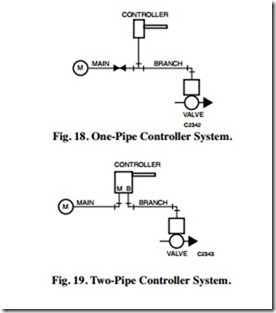CONTROLLERS
GENERAL
A controller is the same as a thermostat except that it may have a remote sensing element. A controller typically measures and controls temperature, humidity, airflow, or pressure. Controllers can be reverse or direct acting, proportional or two- position, single or two pressure, and bleed, feed and bleed, or pilot bleed.
A two-position controller changes branchline pressure rapidly from minimum to maximum (or from maximum to minimum) in response to changes in the measured condition, thus providing ON/OFF operation of the controlled device.
A proportional controller changes branchline pressure incrementally in response to a change in the measured condition, thus providing modulating operation of the controlled device.
A proportional-integral (PI) controller adds to the proportional controller a component that takes offset into account. The integral component eliminates the control point offset from the setpoint.
Bleed-type controllers can be used in one-pipe or two-pipe configurations. In a one-pipe system (Fig. 18), the main air goes through a restrictor to the controller and actuator in the most expeditious routing. In a two-pipe system (Fig. 19), the main air goes into the controller, through an internal restrictor in the controller, and out of the controller through a branch line to the actuator. All pilot-bleed and feed-and-bleed controllers are two pipe.
Controllers may also be classified as single-pressure or two- pressure controllers. Single-pressure controllers use a constant main air pressure. Two-pressure controllers use a main air pressure that is alternately switched between two pressures, such as 13 and 18 psi. For example, occupied/unoccupied controllers automatically change setpoint from a occupied setting at a mainline pressure of 13 psi to a lowered unoccupied setting at 18 psi. Heating/cooling controllers change from reverse acting at mainline air pressure of 13 psi for cooling to direct acting at 18 psi for heating.
